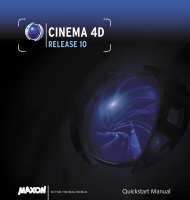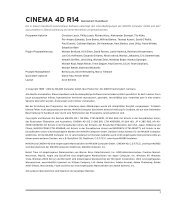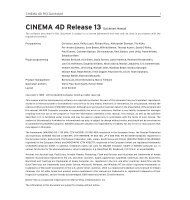Optional module - Maxon Computer
Optional module - Maxon Computer
Optional module - Maxon Computer
Create successful ePaper yourself
Turn your PDF publications into a flip-book with our unique Google optimized e-Paper software.
68 CINEMA 4D R11 Quickstart – Rendering<br />
If all you need is a quick preview of your animation you can save yourself the trouble of always opening and<br />
changing the Render Settings by selecting the preview function (Render / Make a Preview). The settings used<br />
here are kept to a minimum.<br />
Of course the “Output“ and “Save“ settings depend on the requirements of your scene. If you render a single<br />
image that will be printed with a resolution of 300dpi on a 8.5x11 size page you should render the image with a<br />
resolution of at least 2550 x 3300. If you want to print the image in a picture size of 3x5, a render resolution of<br />
1000 x 1500 will be more than enough. By the way, there are many services that will print your digital images.<br />
Maybe you can send us your first CINEMA 4D work of art as a Holiday card!<br />
Animation is a different story. The frame rate, which is also editable in the “Output“ menu of the Render<br />
Settings, plays an important role in animation. The frame rate is the speed at which the animation plays. A frame<br />
rate of 25 means that 25 images per second will be played. If you produce an animation for the European market<br />
you will have to adhere to the PAL standard which uses an output size of 768 x 576 pixels and a frame rate of<br />
25. If you produce a film the frame rate must be set to 24 and a much higher resolution that for television.<br />
11. Quick Tutorial – Multi-Pass Rendering<br />
As you have read in the previous chapter rendering can take up a lot of time. The last thing you want to have to<br />
do is render a long animation a second time because you accidentally set a wrong property. Let’s say you look<br />
at your film again the next day and realize the specular light on the sphere was set much too bright. Or worse,<br />
you’re a 3D professional and a client is looking over your shoulder telling you he would rather have the pink<br />
panther dove blue! Now you have to create a new texture for the character and render the entire animation<br />
again – unless you had secretly activated Multi-Pass rendering. With the help of Multi-Pass rendering you can<br />
place 3D objects in front of a real background (keyword: compositing) or you can use filters in post-production<br />
to make the images more attractive. In this chapter we will show you how to use Multi-Pass rendering so we<br />
can take away the hassle of clients who want you to make unexpected changes to a project ASAP.<br />
Open the file “QS_MultiPass.c4d“. The time slider is set to frame 15. We want to render this frame and<br />
subsequently make changes to it using an image editing software. Open the Render Settings (Render / Render<br />
Settings) and select Multi-Pass.









